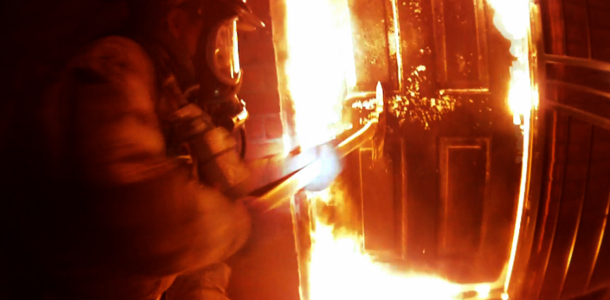Putnam and Sanchez Help Fight Detroit’s Inferno
As with most public sectors in Detroit ringing the budgetary bell of doom, public scrutiny of the fire department seems to have risen to an all time high. When Putnam and Sanchez pitched the film, they were met with the same staunch resistance as the predatory media that have been turning up the heat on the Mayor’s office, but it turns out that their film meant to showcase the struggle in the streets rather than critique political policy behind closed doors. After being granted approval, the film crew was assigned to Engine Company 50 on the city’s east side and quickly found themselves in the midst of 21 firefights within just their first two days of shooting.
The men that populate the tightly knit firehouse morning, noon and night regard themselves as family, a band of brothers with a love of their profession. We meet an aged veteran on the verge of retirement, a host of hairless heroes hoping for a slight pay cut so they can qualify for food stamps and a young man who’s lost mobility from the torso down at the hands of a cascading wall of disassembling brick and flame. Many of these men followed in the footsteps of their fathers or uncles with the same sense of valor and pride a soldier might enter the armed forces. They see the job as a noble duty, one with the potential to save lives, but one that also offers the thrills of adrenaline-pumping combat from the comforts of home. Burn often follows this impulse, portraying fires with the same hyper cutting and metal soundtracks as multiplayer shootout YouTube compilations. While as an exciting introduction to the extremes in which these men function or falter, the notion works, but when placed flatly against the quiet strife of everyday life without functioning legs, the gravity of the situation is undercut by blockheaded provocation.
Trying to sideline some of these nonsensical battles against hollow, but dangerous foe, the newly appointed, LA-imported fire chief is also seen bluntly expounding the problems his department faces with his inherited assemblage. Fire engines are literally being held together with duct tape, fire houses are being put into ‘brown out’ (meaning no emergency units in operation) and fire fighters are being injured due to overwork and faulty equipment. It isn’t until the death of a young girl who’s life might have been saved that the chief is forced take direct action. The small fire unit that arrived at her burning house was not authorized to make use of the out-of-service pump that their truck was outfitted with. His reaction was to enact a new policy aiming to save both lives and city money while allowing priority coverage in the event of multiple infernos – if it’s empty, let it burn. And burn they shall.
Through Putnam and Sanchez’s lens, Detroit seems but a house of cards built upon match-boxes ready to be struck, but it’s the spirit of the fire fighter that they strive to capture. It is in the brief moments of downtime we see the men for what they really are. Beneath the gas masks and fire suits are people who just want to serve their community, helping their beloved city of Detroit to be just a little bit safer, hoping to make it a better place to raise their families. The film salutes these men with heart pounding intensity and promotes their efforts with sombre apprehension, but what Burn does best, though, is remind why most of us have changed our childhood dreams of firemanship to something a little less dangerous.
